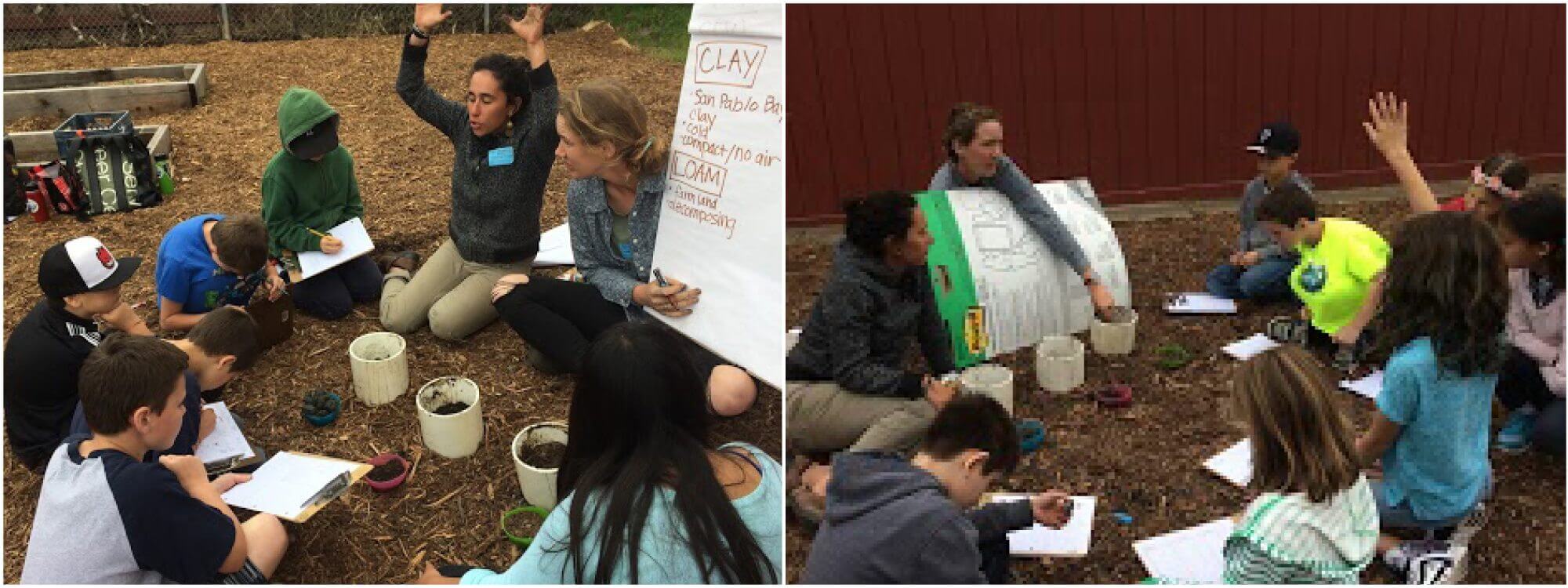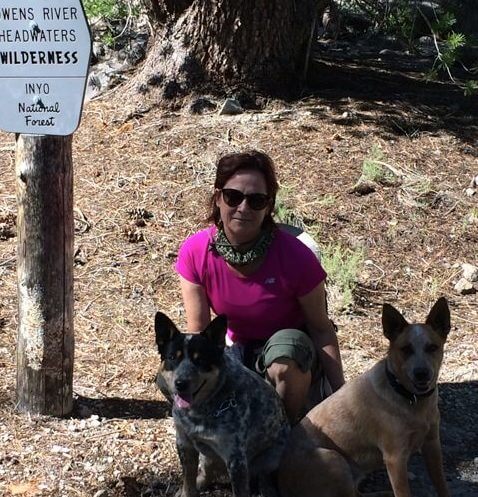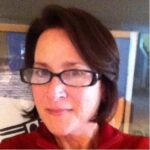I enjoyed a much needed sojourn into the Eastern Sierras this summer. For two weeks, my husband, our two Queensland Heelers, and I cruised our truck camper in and out of the mountains north and south of Bridgeport, California. We hiked every day through quiet forests, alongside rushing rivers and churning waterfalls. The dogs frolicked on large patches of snow that we crossed on the trails, while my husband savored a few casts into pristine alpine lakes. Every day there was something to observe and wonder about. How did this huge mountain of obsidian rock come to be in the middle of the forest? Why was the water in one river sparkly clear, but a river just over the ridge, brown with turbidity? What was that bear (seen from a safe distance!) munching on along the stream? This time spent in nature refreshed my spirit and reinforced my determination to continue using the environment as a core vehicle for teaching science and environmental literacy in my classroom.
I have taught grades 1–6 over my 29-year career as an elementary teacher. I also spent three years as a TOSA (teacher on special assignment), for science and Common Core support. This position was sponsored in part by the BaySci Consortium out of the Lawrence Hall of Science to support the development of quality science instruction and, later, the transition to the Next Generation Science Standards in our district. Those three years were a tremendous learning period that provided valuable connections to people and resources, particularly in environmental education. Such people and resources included SEEC (Sonoma Environmental Education Collaborative) and ChangeScale, an umbrella organization that facilitates the collaboration of environmental education providers in the Bay Area.
SEEC is currently supporting two of our elementary schools in an Environmental Learning Pathways pilot program to strengthen the partnerships between classrooms and our local providers, while ChangeScale is working with the entire district to create K–12 pathways to help ensure that all students achieve environmental literacy by graduation. To date, a committee has surveyed teachers in the district about their environmental education activities, and professional development was presented to teachers on August 11. I was pleased to help my district participate in these programs and be on the cutting edge for meeting the expectations of California’s Blueprint for Environmental Literacy and the California Science Standards. I believe that both pilot initiatives have tremendous potential to help teachers meet content and Common Core standards through the context of the environment—thus providing students with more timely and critical real-world learning.
Last year, due to financial and administrative changes in the district, I returned to the classroom as a fourth grade teacher. While I missed the satisfaction of supporting teachers and the district, I knew that this was my opportunity to “walk the talk” regarding the instructional and content shifts I had learned and promoted as a TOSA. My personal driving question became, “How can I design and model an integrated science–environmental literacy program?” The first thing I did was create an overarching theme for the year that would help me integrate as many subjects and activities as possible. Because I had attended two summers of professional development at the Educator Academy in the Amazon Rainforest, I also wanted the theme to include local–global connections. “Exploring Local and Global Environments—Past, Present, and Future” was painted on a large banner that was hung prominently in the front of my classroom.
Next, I gave some thought to how I might harness the resources and support of two local environmental education providers, the Watershed Classroom program and STRAW (Students and Teachers Restoring a Watershed). The Watershed Classroom offered professional development from BEETLES that taught me routines for taking students outside, science notebooking using the Nature Journaling Curriculum by John Muir Laws, and the three simple, yet powerful inquiry sentence starters: I notice, I wonder, and It reminds me of. These were posted alongside the banner with the overarching theme. The Watershed Classroom also paid me a stipend to write a project-based learning unit incorporating the local watershed. STRAW provided wonderful professional development, classroom visits, and assistance with opening up access to a creek that borders my school campus. Additional resources I embedded into this year-long watershed focus were the EEI (Education and the Environment Initiative) Curriculum social studies units (from California’s Office of Education and the Environment) and portions of the FOSS science and Mystery Science programs.
 Did I meet my goals last school year? In large part, yes. Successes included spending the first six weeks of school focused on creating a classroom culture of inquiry. I used activities from the book, How to be an Explorer of the World: Portable Life Museum by Keri Smith, and exploration and investigation routines from BEETLES. We began using our science notebooks. I got the kids outside more to do field-study work on the campus grounds and during several walking field trips to our local creek. Additional field trips to local environmental education provider locations like the Environmental Discovery Center supported our overarching theme as well. Further, I was able to to have the students make a strong connection to the Amazon rain forest and watershed through my personal stories and photos.
Did I meet my goals last school year? In large part, yes. Successes included spending the first six weeks of school focused on creating a classroom culture of inquiry. I used activities from the book, How to be an Explorer of the World: Portable Life Museum by Keri Smith, and exploration and investigation routines from BEETLES. We began using our science notebooks. I got the kids outside more to do field-study work on the campus grounds and during several walking field trips to our local creek. Additional field trips to local environmental education provider locations like the Environmental Discovery Center supported our overarching theme as well. Further, I was able to to have the students make a strong connection to the Amazon rain forest and watershed through my personal stories and photos.
We compared and contrasted the relationships between California Native peoples and the Yagua tribe, and between erosion along the Amazon river and current gold mining practices. A highlight was a Skype session with Marie Trone, a research scientist who studies the pink river dolphins of the Amazon. At our school site, we initiated steps to create access to a part of the local creek that borders one side of our campus. Instructors from STRAW helped the students gather and analyze baseline data of plants, water quality, and soil from the creek. During a follow up session, they had the students begin designing creek restoration plans. In the bigger picture, the overarching theme of “Exploring Local and Global Environments —Past, Present, and Future” supported the overall success of the year by enabling my students and me to make ongoing cross-curricular connections. You can take a look at last year’s activities with photos, descriptions, and focal questions on our class website and check out the video below.
The 2017–18 school year is on my mind now, of course, with the following driving question: How can I build on and improve last year’s momentum of integrating science and environmental literacy across the curriculum? I still have more fleshing out to do, but some of the things I am considering are: using the California Academy of Sciences ideas to introduce science notebooking at the beginning of the year, and how to more intentionally embed the EP&Cs (California’s Environmental Principles and Concepts) into instruction. EEI materials currently address them, as will future state-adopted social studies and science curriculum. I am also wondering how I might teach about California’s system of government through an environmental literacy lens. Finally, I will be working with STRAW to implement a grant I received from NOAA’s Climate Stewards program. Part of the award will be used to remove invasive plants and replace them with natives. Another part of the grant will be spent on equipment such as camera traps that will aid our efforts to inventory wildlife that lives on or near the school campus. The data we collect from the cameras and from Schoolyard BioBlitz surveys will be used to enhance and create wildlife habitat. Before the end of the summer, I intend to write a project-based learning unit to pull all of the above plans into a cohesive storyline, correlated to relevant standards and resources.
The school year ahead is full of promise for my goal of going deeper with the integration of environmental literacy. I am encouraged and motivated by the partnerships my district is developing with the Lawrence Hall of Science, ChangeScale, and our local environmental education providers. As I plug away on my curriculum plans these last few weeks of summer, I will also get in more outdoor time myself—be it on a trail, in a kayak, or in my own backyard to observe, wonder, and appreciate the local birds!




6 Responses
What a great and inspiring telling of your epic return to the classroom! Thanks for sharing all this, Kirsten. Lucky Petaluma 4th graders! And thanks, Ten Strands, for providing this platform for telling great stories!
Your story of “walking the talk” is inspiring. Thank you for sharing your teaching and learning journey (and the plethora of resources! 🙂
Your passion for science and the environment has always been and remains evident, in your classroom and your job as TOSA and your outside endeavors like this. Your students and colleagues are lucky. Thanks for sharing.
Inspirational! Thanks for the reminders, temptations and solid support.
Kirsten, thank you for sharing your story and ongoing process of being an amazing teacher! Keep spreading the good word about engagement with local environmental resources, education resources to engage students in real world learning!
Kirsten, Thank you for sharing! It is so great to hear how you took so many different resources and turned them into cohesive experiences for your students. Thanks for including so many details that really help us understand your process!